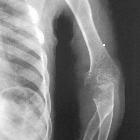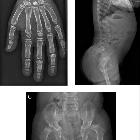pseudoachondroplasia

Pseudoachondroplasia.
Left upper limb. Note the dysplastic proximal humeral epiphyses, metaphyseal broadening, irregularity and metaphyseal line of ossification. These changes are collectively known as "rachitic-like changes". Similar lesions are noticed in the remainder of the limb especially distal radius and ulna.

Pseudoachondroplasia.
Knee radiographs AP view of a child depicting dysplastic distal femoral and proximal tibial epiphyses, with distal femoral metaphyseal broadening and irregularities. Note the metaphyseal lines of ossification of the proximal tibias and distal femora and relative sparing of the tibial shafts. The changes around the knee are known as "rachitic-like changes". Lesions are fairly symmetrical. Note the internal fixation implants used to correct a femoral valgus and tibial varus deformity.

Pseudoachondroplasia.
Shoulders and Humeri. Note the dysplastic proximal humeral epiphyses, metaphyseal broadening, irregularity and metaphyseal line of ossification. These changes are collectively known as "rachitic-like changes". Lesions are bilateral and symmetrical.

Pseudoachondroplasia.
Leg radiographs depicting dysplastic distal femoral and proximal tibial epiphyses, and distal femoral metaphyseal broadening, cupping, irregularities (white arrows) and radiolucent areas especially medially. Note the metaphyseal line of ossification of the proximal tibias (blackarrows) and relative sparing of the tibial shafts. The changes around the knee are known as "rachitic-like changes". Lesions are bilateral and symmetrical.
Pseudoachondroplasia (PSACH) refers to an osteochondrodysplasia which is characterized by
- rhizomelic dwarfism
- limb and vertebral deformities
- joint laxity
- early onset osteoarthrosis
It is also characterized by the absence of abnormality at birth and a normal craniofacial appearance.
Pathology
Due to mutations in the gene encoding cartilage oligomeric matrix protein. Pathognomonic changes of vertebral bodies are thought to invariably disappear around the age of 10.
Genetics
It carries an autosomal dominant inheritance .
See also
Siehe auch:

 Assoziationen und Differentialdiagnosen zu Pseudoachondroplasie:
Assoziationen und Differentialdiagnosen zu Pseudoachondroplasie:




